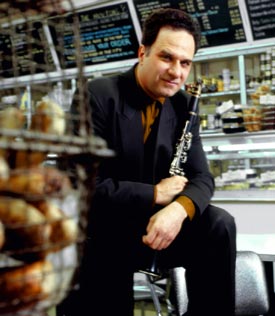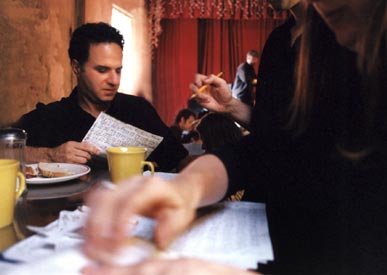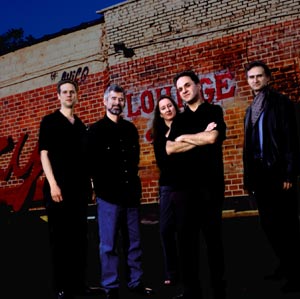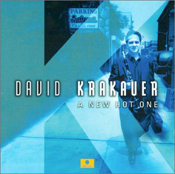|
Raising a Ruckus
The Jewish jazz innovator talks with Christina Roden
The New York-based clarinetist David Krakauer has been raising eyebrows,
spirits and an occasional ruckus with his inventive, hot-blooded, and edgy
take on Jewish klezmer music. His albums reflect a deep affection for this
formerly endangered tradition even as he boldly takes it into the present and
anticipates the future. His sound is an electrifying amalgam of cozy Eastern
European traditions, free-form jazz, and dissonant howls of rage and pain
torn from centuries of village celebrations and religious persecution.
Krakauer's potent, bittersweet statement of personal and collective race
memory has attracted enthusiastic new audiences to klezmer wherever he goes
throughout the US, Europe, and the world.
|
 All photos by Aldo Mauro
All photos by Aldo Mauro
|
The word "klezmer" is derived from "kley" and "zemer," Yiddish words that
mean roughly "instrument of song." It was a ubiquitous part of weddings and
other festive occasions during the 19th and early 20th centuries, providing a
lively soundtrack to the earthy and difficult realities of rural shtetl
(Jewish villages that once existed throughout Russia and Eastern Europe)
life. Groups of itinerant musicians, ranging from small combos to large
orchestras, traveled from place to place, their large repertoires of
freylekhs, bulgars, horas, s�rbas, and doinas at the ready. But even though
no party was complete without them, most musicians were considered to be
little more than shiftless tramps and this social attitude persisted among
Jewish populations, no matter where they lived. Not many families were
terribly supportive when a child chose to pursue music as a career.
Klezmer (the word describes the music and the musician) was brought to the
United States by homesick Jewish immigrants. Along with Yiddish theater, the
style enjoyed an American heyday during the early 20th century but as
succeeding generations sought a more assimilated lifestyle, klezmer gradually
fell out of favor.By the forties, aspects of klezmer and Yiddish theater
turned up in big band tunes or became hits for pop stars, but most people,
even Jews, had no idea where the tunes came from. By the seventies, although
the lost folkways were glorified by the musical "Fiddler On The Roof", prewar
Yiddish culture was nearly extinct in the United States. It was then that an
entire generation of young "cultural Jews" began trying to figure out who
they were and where they came from. David Krakauer was among these.
 Like many of his contemporaries, Krakauer has strong Ashkenazy (Eastern
European Yiddish) roots, but these were not emphasized during his formative
years. Although the traditional cuisine made it through, the high holidays
were observed, and he had a Bar Mitzvah celebration; hard-core religion and
traditions from another time and place were almost entirely absent from his
upbringing. Thus, his route to becoming a latter-day exponent of a music that
his grandparents probably loved was circuitous and indirect. His family
always listened to classical music and the young Krakauer was first attracted
to the clarinet via that repertoire. By the time he made it to Juilliard, he
was also heavily involved in the New York jazz scene, which led to still more
discoveries.
Like many of his contemporaries, Krakauer has strong Ashkenazy (Eastern
European Yiddish) roots, but these were not emphasized during his formative
years. Although the traditional cuisine made it through, the high holidays
were observed, and he had a Bar Mitzvah celebration; hard-core religion and
traditions from another time and place were almost entirely absent from his
upbringing. Thus, his route to becoming a latter-day exponent of a music that
his grandparents probably loved was circuitous and indirect. His family
always listened to classical music and the young Krakauer was first attracted
to the clarinet via that repertoire. By the time he made it to Juilliard, he
was also heavily involved in the New York jazz scene, which led to still more
discoveries.
Chatting over lunch at a Cuban-Chinese restaurant on New York's Upper West
Side, Krakauer describes his initial attraction to klezmer. "My grandmother
had a heavy Yiddish accent," he recalls, "so, when I first heard klezmer
music, I said, 'this is totally familiar, it sounds like Grandma talking."
When I started to play, I had to study carefully because the style is so
specific. There are tunes, ornaments, phrasing and inflections; what I call
the 'laws.'" He sought out the few remaining living masters; "I heard Dave
Taras play down on Grand Street in 1979. This was a famous concert and as
soon as he played a note, I got goose-bumps all over my body. So I listened
to records by old clarinet players like Neftule Brandwein, tried to master
the style. Then I added in my own influences." He says that the esoteric
tunings and scales that are the basis of klezmer and Balkan music had to be
approached from the inside. "There are three basic klezmer modes. To
improvise freely and have fun, you have to get them into your blood."
As a jazz man, he was surprised and delighted to discover that American big
band musicians had been influenced by klezmer or played it outright, even
prior to the Andrews Sisters' hit, "Bei Mir Bist Du Schein". Krakauer
relates, "Benny Goodman's band played 'And The Angels Sing,' and this is
actually an old klezmer tune called 'Der Stiller Bulgar!' And one time while
I was on tour in Germany, I was flipping through TV stations after a gig,
trying to unwind. I saw this movie called 'On An Island With You,' and there
was Xavier Cugat playing a klezmer song! I thought 'Krakauer, you're losing
your mind!'"
 As Krakauer's private version of klezmer evolved, he began to perform with
the Klezmatics, an avant-garde ensemble who bring barbed social commentary,
sexual politics, and other anarchistic twists into their sound. Krakauer
reminisces, "We were on tour in East Germany. It was 1990 and the wall had
just fallen. We were with this English punk band called 'The Men They
Couldn't Hang' so we were saying, 'We should call ourselves 'The Jews They
Didn't Burn!'" Later on, he met and collaborated with John Zorn, a jazz and
new music icon who also expresses his rediscovered Jewish heritage in an
inventive, non-nostalgic manner. "Zorn invited me to play when he was
recording his piece 'Kristallnacht,' which was also performed at the Munich
Art Project in 1992. It was a historic moment - that was the first time the
phrase, 'radical Jewish culture' was brought up. I mean, we had Lou Reed on
the same bill, outing himself as a Jew! Shortly after that, Zorn said 'Hey,
Krakauer, you ever record under your own name?' and I said 'No.' A couple of
days later, we were at the Knitting Factory and Zorn rummages through this
bag of mouthpieces, reeds and microphone cables and pulls out a check.
'Here's a few grand,' he says, 'now go and make a record.' It was so
beautiful!" Krakauer eventually released albums with his trio and a group he
calls "Klezmer Madness" on Zorn's Tzadik label.
As Krakauer's private version of klezmer evolved, he began to perform with
the Klezmatics, an avant-garde ensemble who bring barbed social commentary,
sexual politics, and other anarchistic twists into their sound. Krakauer
reminisces, "We were on tour in East Germany. It was 1990 and the wall had
just fallen. We were with this English punk band called 'The Men They
Couldn't Hang' so we were saying, 'We should call ourselves 'The Jews They
Didn't Burn!'" Later on, he met and collaborated with John Zorn, a jazz and
new music icon who also expresses his rediscovered Jewish heritage in an
inventive, non-nostalgic manner. "Zorn invited me to play when he was
recording his piece 'Kristallnacht,' which was also performed at the Munich
Art Project in 1992. It was a historic moment - that was the first time the
phrase, 'radical Jewish culture' was brought up. I mean, we had Lou Reed on
the same bill, outing himself as a Jew! Shortly after that, Zorn said 'Hey,
Krakauer, you ever record under your own name?' and I said 'No.' A couple of
days later, we were at the Knitting Factory and Zorn rummages through this
bag of mouthpieces, reeds and microphone cables and pulls out a check.
'Here's a few grand,' he says, 'now go and make a record.' It was so
beautiful!" Krakauer eventually released albums with his trio and a group he
calls "Klezmer Madness" on Zorn's Tzadik label.
 On A New Hot One, there is mournful little waltz called "Love Song For
Lemburg/Lvov", which was a result of Krakauer's recent visit to his
grandfather's home town. The fragile melody periodically crashes into
cacophony as though reliving the horrors of Holocaust. "That piece functions
on many levels." Krakauer confides, "I was thinking about the beauty of this
'little Vienna', or 'little Paris', but then there's the dark underside, of
Jews getting their butts kicked!" With this in mind, the discussion shifts to
the overwhelming and to many, somewhat disturbing, popularity of klezmer
music in former Nazi strongholds like Germany and Poland. Krakauer explains
thoughtfully, "It would easy to say it's some kind of guilt-cleansing, but
my feeling is that Klezmer was the soul music of Europe and a strong part of
the musical structure. In Poland, klezmer is considered a lost branch of jazz
and also a new conduit. I have an investment in keeping klezmer alive, so
it's a tremendous thrill to play in these places. Most of the audience is my
age or younger, so it's a new hope for them - and for me!"
On A New Hot One, there is mournful little waltz called "Love Song For
Lemburg/Lvov", which was a result of Krakauer's recent visit to his
grandfather's home town. The fragile melody periodically crashes into
cacophony as though reliving the horrors of Holocaust. "That piece functions
on many levels." Krakauer confides, "I was thinking about the beauty of this
'little Vienna', or 'little Paris', but then there's the dark underside, of
Jews getting their butts kicked!" With this in mind, the discussion shifts to
the overwhelming and to many, somewhat disturbing, popularity of klezmer
music in former Nazi strongholds like Germany and Poland. Krakauer explains
thoughtfully, "It would easy to say it's some kind of guilt-cleansing, but
my feeling is that Klezmer was the soul music of Europe and a strong part of
the musical structure. In Poland, klezmer is considered a lost branch of jazz
and also a new conduit. I have an investment in keeping klezmer alive, so
it's a tremendous thrill to play in these places. Most of the audience is my
age or younger, so it's a new hope for them - and for me!"
- Christina Roden
A New Hot One is available at cdroots.com
Photos ©2001 Aldo Mauro
|



